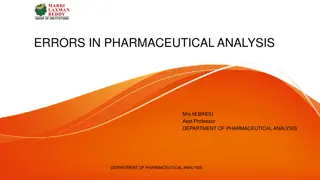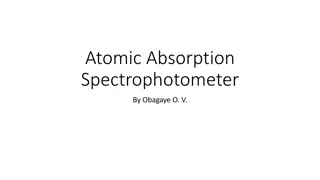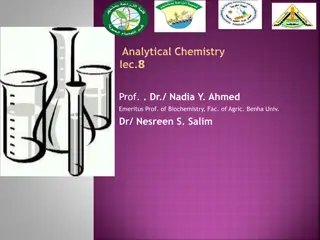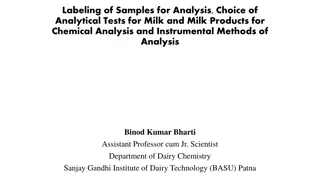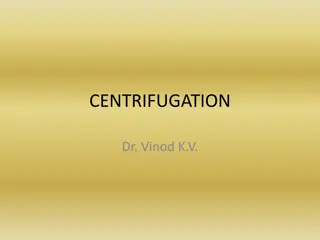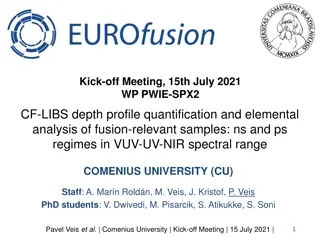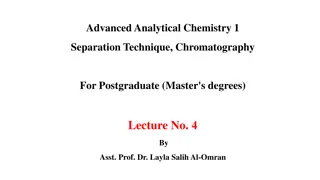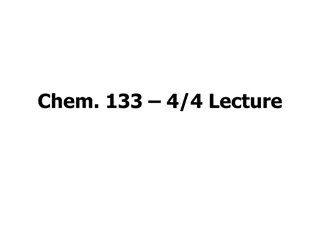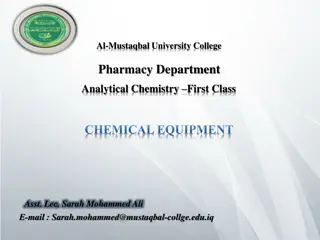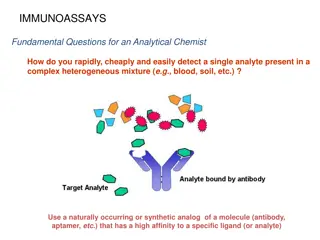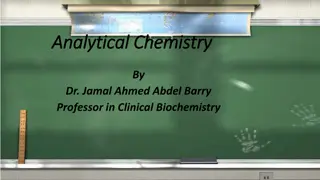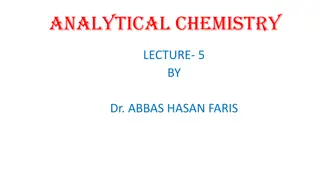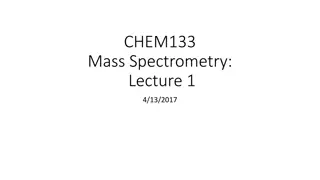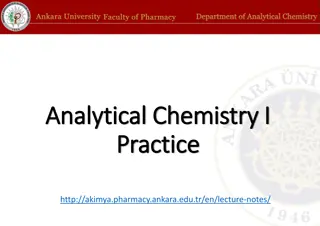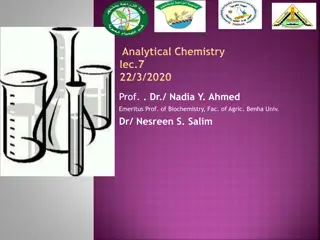Systematic Analysis of Real Samples in Analytical Chemistry
This analysis covers the systematic process involved in analyzing real samples, including sampling, sample preservation, and sample preparation. It discusses the importance of accurate sampling in obtaining information about various substances, such as solids, liquids, gases, and biological materials. The focus is on designing a sampling plan for both qualitative and quantitative analyses to ensure the representativeness of the samples collected. The challenges of sampling errors and the concept of random sampling are also explored in this study.
Download Presentation

Please find below an Image/Link to download the presentation.
The content on the website is provided AS IS for your information and personal use only. It may not be sold, licensed, or shared on other websites without obtaining consent from the author. Download presentation by click this link. If you encounter any issues during the download, it is possible that the publisher has removed the file from their server.
E N D
Presentation Transcript
Real Sample Analysis (Chem. 3118) Salasib.A(M.Sc) Bonga University salasibatumo555@gmail.com Recommended textbook: Sample Preparation Techniques in Analytical Chemistry Edited by Somenath Mitra salasibatumo555@gmail.com /salolemo@yahoo.com 1
Out line Systematic analysis of real samples Sampling, Sample preservation Sample preparation Biological samples Food and beverages samples Water and waste water samples 2 salasibatumo555@gmail.com /salolemo@yahoo.com
Chapter 1(real sample analysis ) The purpose of an real sample analysis study is to obtain information about some object or substance. The substance could be a solid, a liquid, a gas, or a biological material. The information to be obtained can be varied. It could be the chemical or physical composition, structural or surface properties, or a sequence of proteins in genetic material. Sampling: where the sample is obtained from the object to be analyzed. This is collected such that it represents the original object. Sampling is done with variability within the object in mind. salasibatumo555@gmail.com /salolemo@yahoo.com 3
Contd What is sampling? Why do we need to sample materials for analysis? Sampling is the most difficult step and the greatest source of error during analysis. In a qualitative analysis the sample s composition does not need to be identical to that of the substance being analyzed, provided that enough sample is taken to ensure that all components can be detected. In a quantitative analysis, however, the sample s composition must accurately represent the target population. The focus of this section, therefore, is on designing a sampling plan for a quantitative analysis. Four questions should be considered when designing a sampling plan: 4 salasibatumo555@gmail.com /salolemo@yahoo.com
Cont I. II. What type of samples should be collected? III. What is the minimum amount of sample needed for each analysis? IV. How many samples should be analyzed? A From where within the target population should sample be collected Sampling errors occur when a sample s composition is not identical to that of the population from which it is drawn. When the material being sampled is homogeneous, individual samples can be taken without regard to possible sampling errors. Unfortunately, in most situations the target populations is heterogeneous From where within the target population should sample be collected? salasibatumo555@gmail.com /salolemo@yahoo.com 5
Contd Random Sampling :a true random sample is difficult to obtain. The best method for ensuring the collection of a random sample is to divide the target population into equal units, assign a unique number to each unit, and use a random number table to select the units from which to sample Three methods are commonly used to obtain samples: Grab Sampling Composite sampling In suit sampling salasibatumo555@gmail.com /salolemo@yahoo.com 6
1.Grab Sampling: in which a portion of the target population is removed at a given time and location in space. Provides a snapshot of the target population. Then taking the average. 2. Composite sample Consists of a set of grab samples that are combined to form a single sample. Then take various replicate samples Composite samples may be used to reduce the analytical cost by reducing the number of samples. 3. In situ sampling, in which an analytical sensor is placed directly in the target population, allows continuous monitoring without removing individual grab samples. salasibatumo555@gmail.com /salolemo@yahoo.com 7
Advantage and Disadvantage of grab sampling Advantage Limitations inaccurate; Low cost Result depends up on positioning of the tube Save the time Operators need little experience Only a snap shot is taken during a small amount of time; Gives indication during emergency spillages The pump may be inefficient or inaccurate in each sample salasibatumo555@gmail.com /salolemo@yahoo.com 8
Contd A significant disadvantage of grab samples and composite samples is the need to remove a portion of the target population for analysis. As a result, neither type of sample can be used to continuously monitor a time-dependent change in the target population. N.B while collecting samples for determination of Ca2+ in a lake, it should be kept in mind that its concentrations can vary depending on the following factors Location Depth Time of year salasibatumo555@gmail.com /salolemo@yahoo.com 9
Glossary Bulk sample:(also called gross sample, lot sample) one or more increments of material taken from a population for analysis or record purposes. Composite sample: a sample composed of two or more increments collected from different locations within a population or from the same location more than one time. Grab sample:(also called discrete sample) a single increment collected from a population at a specific time and location. Laboratory sample: a sample, intended for testing or analysis, usually prepared from a bulk sample in one or more sub sampling steps. The laboratory sample must retain the composition of the bulk sample. Reduction in particle size and mixing is typically necessary during its preparation. salasibatumo555@gmail.com /salolemo@yahoo.com 10
Cont. Reduction: the process of preparing one or more sub samples from a sample. Replicate samples: two or more samples collected from a population in an identical manner at the same time and place. Representative sample: a sample collected from a population in a manner that ensures, to the extent possible, that it accurately represents the population, or subset of the population, from which it was taken. Sample: a portion of a population or lot. It may consist of an individual or groups of individuals Spiked sample: a sample to which has been added a known quantity of the analyte to test the extent of interference by the matrix with the analytical measurement. Subsample: a portion taken from a sample. A laboratory sample may be a subsample of a bulk sample; similarly, a test portion may be a subsample of a laboratory sample. salasibatumo555@gmail.com /salolemo@yahoo.com 11
Sample preservation This is an important step, because there is usually a delay between sample collection and analysis. In addition, physical, chemical, and biological processes may be involved in changing the composition of a sample after it is collected. Physical processes that may degrade a sample are volatilization, diffusion, and adsorption on surfaces Chemical changes include photochemical reactions, oxidation, and precipitation. Biological processes include biodegradation and enzymatic reactions. For example, most dissolved metals are table for months, whereas Cr(VI) is stable for only 24 hours. Holding time can be determined experimentally by making up a spiked sample (or storing an actual sample) and analyzing it at fixed intervals to determine when it begins to degrade salasibatumo555@gmail.com /salolemo@yahoo.com12
Contd In addition the main factors affecting sample stability are: A. The nature of the sample B. The sample container C. The addition of preserving reagents to the sample Common steps in sample preservation are the use of proper containers, temperature control and Observance of recommended sample holding time. However, the holding time depends on the analyte of interest and the sample matrix The purpose of sample preservation There are three key issues that often arise that necessitate pre- treatment of a sample prior to analysis: /salolemo@yahoo.com salasibatumo555@gmail.com 13
Contd 1. The sample is in the wrong physical state for the analysis method (e.g. the method requires a liquid but you have a solid sample) 2. The sample has interfering matrix components that may give either a false positive or negative reading in the measurement and 3. The sample has too low an analyte concentration to be detected by the instrument. SAMPLE HANDLING RECOMMENDATIONS The required materials for during sample collection well-rinsed with deionized water, dried, and stored with the caps on to prevent contamination. The bottle should be rinsed with sample water prior to actual sample collection. salasibatumo555@gmail.com /salolemo@yahoo.com 14
Contd The laboratory recommends that the samples be filtered by the investigator as soon as possible after collection The sample can be transported to the laboratory within 24 hours, it should not be frozen or preserved cold and in the dark Unfiltered samples should be frozen until arrival at the laboratory. It is recommended that no acids be added to unfiltered samples as the acidity may cause leaching of the sediments and/or degradation of biological constituents. The volume of sample submitted to the laboratory is dependent on the types of analyses required. In general, most investigators should submit at least 1 liter of sample salasibatumo555@gmail.com /salolemo@yahoo.com 15
salasibatumo555@gmail.com /salolemo@yahoo.com 16
3. Sample preparations Most samples are not ready for direct introduction into instruments. For example, in the analysis of pesticides in fish liver, it is not possible to analyze the liver directly The pesticides have to be extracted into a solution, which can be analyzed by an instrument. There might be several processes within sample preparation itself. Hence analysis by these instruments should be preceded by appropriate sample-preparation steps that concentrate analytes and clean up of interferences salasibatumo555@gmail.com /salolemo@yahoo.com 17
Contd Purpose Of Sample Preparation Purpose may be one or a combination of the following: To homogenize sample or remove moisture: air-drying or freeze- drying, homogenization, grounding, and sieving. Assures that the subsample taken for analysis is representative. To increase/decrease analyte concentration: pre-concentration is needed for almost all trace analysis, To remove interfering chemicals: major issue for trace organic compounds To change sample phase: sample phase may be needed to be changed to fit the instrument To liberate analyte from sample matrix: analyte species may be needed to be liberated from sample matrix salasibatumo555@gmail.com /salolemo@yahoo.com 18
Cont To modify chemical structure: chemical derivatization is used to increase or decrease volatility for HPLC or GC analysis On the other hand, Some of the samples are does not required sample preparations for analysis. e.g Drinking water quality analysis. However, almost all samples are required sample preparations and be very time consuming, e.g. Chromatographic analysis salasibatumo555@gmail.com /salolemo@yahoo.com 19
Sample preparation can be one of the following Off-line They are manual based methods or They are not computerized Online They are fully automated At-line In this case both sample preparation and analysis are automated and takes place simultaneously. The extraction/preconcentration technique is aligned with the instrument salasibatumo555@gmail.com /salolemo@yahoo.com 20
Steps in Sample Preparation The sample preparation may involve: homogenization of the sample in a grinder, followed by extraction, concentration, and cleanup. 1. Homogenization (size reduction) - This can be done by grinding the sample using mortal and pestle or using homoinizing mill. 2. Extraction, - Extraction is the process by which a solute is transferred from one phase to a new phase. salasibatumo555@gmail.com /salolemo@yahoo.com 21
1.Homogenization (size reduction) This can be done by grinding the sample using Mortal and pestle or using homoinizing mill. salasibatumo555@gmail.com /salolemo@yahoo.com 22
2.Extraction Extraction is the process by which the solute is transfer from one phase into another(new phase) Types of extraction liquid liquid extraction (LLE), solid-phase extraction (SPE), and solid-phase micro extraction (SPME). A fourth, recently introduced technique, stir bar Sportive extraction (SBSE), is also discussed salasibatumo555@gmail.com /salolemo@yahoo.com 23
2.1(Liquid-Liquid extraction) When the extraction takes place from one liquid medium to another, the process is referred to as liquid-liquid extraction. i.e. in liquid liquid extraction (LLE), phases A and B are both liquids. The two liquid phases must be immiscible. For that reason, LLE has also been referred to as immiscible solvent extraction. salasibatumo555@gmail.com /salolemo@yahoo.com 24
Liquid-liquid extraction is a useful method to separate components (compounds) of a mixture salasibatumo555@gmail.com /salolemo@yahoo.com 25
Principles of LLE The LLE process can be accomplished by shaking the aqueous and organic phases together in a separatory funnel Following mixing, the layers are allowed to separate. Flow from the bottom of the separatory funnel is controlled by a glass or Teflon stopcock and the top of the separatory funnel is sealed with a stopper. The stopper and stopcock must fit tightly and be leak proof. Commonly, separatory funnels are globe, pear, or cylindrically shaped. They may be shaken mechanically, but are often shaken manually. With the stopcock closed, both phases are added to the separatory funnel. The stopper is added, and the funnel is inverted without shaking. The stop-cock is opened immediately to relieve excess pressure /salolemo@yahoo.com salasibatumo555@gmail.com 26
With the stopcock closed, both phases are added to the separatory funnel. The stopper is added, and the funnel is inverted without shaking. The stop-cock is opened immediately to relieve excess pressure. The separatory funnel should be gently shaken for a few seconds, and frequently inverted and vented through the stopcock. When pressure builds up less rapidly in the separatory funnel, the solvents should be shaken more vigorously for a longer period of time while venting the stopcock occasionally /salolemo@yahoo.com Stopper Stopcock Figure 2.13a salasibatumo555@gmail.com 27
When the layers are completely separated (facilitated by removing the stopper), the lower layer should be drawn off through the stopcock, and the upper layer should be removed through the top of the separatory funnel. The relative position of each layer depends on the relative densities of the two immiscible phases. During an extraction process, all layers should be saved until the desired analyte is isolated. A given solvent layer can easily be determined to be aqueous or organic by testing the solubility of a few drops in water. salasibatumo555@gmail.com /salolemo@yahoo.com 28
Once the analyte has been extracted into phase B, it is usually desirable to reduce the volume of the extracting solvent. This can be accomplished with specialized glassware such as a Kuderna Danish sample concentrator. Alternatively, a mechanical rotary evaporator may be used to evaporate excess extracting solvent, or other evaporating units that evaporate solvent with an inert gas should be used. salasibatumo555@gmail.com /salolemo@yahoo.com 29
salasibatumo555@gmail.com /salolemo@yahoo.com 30
Pre-conditions for using of LLE(Conditions of a choice of solvent which is used as extraction) Should not mix up with water Should be selective The density of the extagent should be difference from water density Should be inexpensive Can not be explosive salasibatumo555@gmail.com /salolemo@yahoo.com 31
Application of solvent extraction Extraction of metals from Petroleum, products, foodstuffs, plant and animal tissue and body fluids Extraction of organic compounds from various matrices after extraction with water salasibatumo555@gmail.com /salolemo@yahoo.com 32
Disadvantage (limitations of liquid liquid Extraction) the use of large amounts of high purity solvents, which are expensive and toxic and result in the production of hazardous laboratory waste its labor and time intensive procedure its tendency to form emulsion its poor potential for automation. its multi-step nature which leads to analyte loss. salasibatumo555@gmail.com /salolemo@yahoo.com 33
2.Solid phase Extraction Solid-phase extraction (SPE) is an extractive technique by which compounds that are dissolved or suspended in a liquid mixture are separated from other compounds in the mixture according to their physical and chemical properties. SPE are used to concentrate and purify samples for analysis. In addition, can be used to isolate analytes of interest from a wide variety of matrices, including urine, blood, water, beverages, soil, and animal tissue. SPE uses the affinity of solutes dissolved or suspended in a liquid (known as the mobile phase) for a solid through which the sample is passed (known as the stationary phase) to separate a mixture into desired and undesired components salasibatumo555@gmail.com /salolemo@yahoo.com 34
Principles of solid phase extraction First, the cartridge is equilibrated with a non-polar or slightly polar solvent, which wets the surface and penetrates the bonded phase Then water, or buffer of the same composition as the sample, is typically washed through the column to wet the silica surface The sample is then added to the cartridge. As the sample passes through the stationary phase, the polar analytes in the sample will interact and retain on the polar sorbent while the solvent, and other non-polar impurities pass through the cartridge After the sample is loaded, the cartridge is washed with a non-polar solvent to remove further impurities Then, the analyte is eluted with a polar solvent or a buffer of the appropriate pH. salasibatumo555@gmail.com /salolemo@yahoo.com 35
salasibatumo555@gmail.com /salolemo@yahoo.com 36
salasibatumo555@gmail.com /salolemo@yahoo.com 37
The difference between LLE and SPE SPE LLE Uses 2 - 20 ml solvent Uses 200 - 500 ml solvent Shaking / continuous process Forms emulsions Little selectivity Takes 1 - 2 hours / sample Filtration process No emulsions formed Wide selectivity (adsorbent) Takes 10 - 20 min. / sample salasibatumo555@gmail.com /salolemo@yahoo.com 38
3. Concentration of Sample Extracts The analytes are often diluted in the presence of a large volume of solvents used in the extraction. This is particularly true when the analysis is being done at the trace level. An additional concentration step is necessary to increase the concentration in the extract Methods used to concentrate sample extracts(small amount of solvents) A.Vaporization using a gentle stream of nitrogen gas If the amount of solvent to be removed is not very large and the analyte is nonvolatile, the solvent can be vaporized by a gentle stream of nitrogen gas Care should be taken that the solvent is lost only by evaporation. If small solution droplets are lost as aerosol, there is the possibility of losing analytes along with it. salasibatumo555@gmail.com /salolemo@yahoo.com 39
salasibatumo555@gmail.com /salolemo@yahoo.com 40
ii. Vaporization using a g rotary vacuum evaporator (Large amount of solvents) In this case, the sample is placed in a round bottomed flask in a heated water bath. A water-cooled condenser is attached at the top, and the flask is rotated continually to expose maximum liquid surface to evaporation. Using a small pump or a water aspirator, the pressure inside the flask is reduced. The mild warming, along with the lowered pressure, removes the solvent efficiently, and the condensed solvent distills into a separate flask. Evaporation should stop before the sample reaches dryness salasibatumo555@gmail.com /salolemo@yahoo.com 41
Rota vapor salasibatumo555@gmail.com /salolemo@yahoo.com 42
4. Sample Cleanup Sample cleanup is particularly important for analytical separations such as GC, HPLC, and electrophoresis. Many solid matrices, such as soil, can contain hundreds of compounds. These produce complex chromatograms, where the identification of analytes of interest becomes difficult. This is especially true if the analyte is present at a much lower concentration than the interfering species. So a cleanup step is necessary prior to the analytical measurements. In addition, complex matrices such as, soil, biological materials, and natural products often require some degree of cleanup salasibatumo555@gmail.com /salolemo@yahoo.com 43
Contd On the other hand, drinking water samples are relatively cleaner (as many large molecules either precipitate out or do not dissolve in it) and may not require cleanup The following techniques are used for cleanup and purification of extracts. 1. Gel-Permeation Chromatograph Gel-permeation chromatography (GPC) is a size-exclusion method that uses organic solvents (or buffers) and porous gels for the separation of macro-molecules The packing gel is characterized by pore size and exclusion range, which must be larger than the analytes of interest is recommended for the elimination of lipids, proteins, polymers, copolymers, natural resins, cel-lular components, viruses, steroids, and dispersed high-molecular-weightcompounds from the sample salasibatumo555@gmail.com /salolemo@yahoo.com 44
Contd This method is appropriate for both polar and non polar analytes. Therefore, it is used for extracts containing a broad range Usually, GPC is most % efficient for removing high-boiling materials that condense in the injection port of a GC or the front of the GC column 2. Solid-Phase Extraction and Column Chromatography This is a common cleanup method that is widely used in biological, clinical, and environmental sample preparation. For detail explanation refer (Slide #: 34 -37) salasibatumo555@gmail.com /salolemo@yahoo.com 45
4. Analysis Once the sample preparation is complete, the analysis is carried out by an instrument of choice. A variety of instruments are used for different types of analysis, depending on the information to be acquired: for example; chromatography for organic analysis, atomic spectroscopy for metal analysis, capillary electrophoresis for DNA sequencing, and electron microscopy for small structures. Common analytical instrumentation and the sample preparation associated with them are listed in Table 1.1. The sample preparation depends on the analytical techniques to be employed and their capabilities. For instance, only a few microliters can be injected into a gas chromatograph. salasibatumo555@gmail.com /salolemo@yahoo.com 46
salasibatumo555@gmail.com /salolemo@yahoo.com 47
Discuss on the following issue how one can collect representative sample Collection of edible fruit samples for trace metals analysis from near by Bonga University Collection of waste water discharged from tannery factory near by river Collection of soils from corn farm of one of the selected Woreda in Kafa Zone salasibatumo555@gmail.com /salolemo@yahoo.com 48
Preparation of sample for metal analysis Metals contained in samples are determined by a wide variety of analytical methods. Bulk metals, such as copper in brass or iron in steel, can be analyzed readily by chemical methods such as gravimetric or electrochemistry However, many metal determinations are for smaller, or trace, quantities. These are determined by various spectroscopic or chromatographic method such as: Atomic absorbance spectrometry using flame (FAAS) or graphite furnace (GFAAS) atomization, Atomic emission spectrometry (AES), Inductively coupled plasma atomic emission spectrometry (ICP-AES), Inductively coupled plasma mass spectrometry (ICP-MS), x-ray fluorescence Ion chromatography (IC) /salolemo@yahoo.com salasibatumo555@gmail.com 49
Contd Preparation of materials for determination of their metal content serves several purposes, which vary with the type of sample and the demands of the particular analysis. Some of the major functions of sample preparation are: To degrade and solubilize the matrix, to release all metals for analysis To extract metals from the sample matrix into a solvent more suited to the analytical method to be used. To concentrate metals present at very low levels to bring them into a concentration range suitable for analysis. To separate a single analyte or group of analytes from other species that might interfere in the analysis. To dilute the matrix sufficiently so that the effect of the matrix on the analysis will be constant and measurable. salasibatumo555@gmail.com /salolemo@yahoo.com 50








